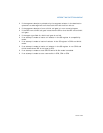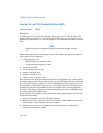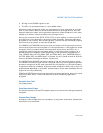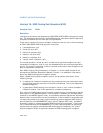
Vol. 3 6-59
INTERRUPT AND EXCEPTION HANDLING
Prior to executing a waiting x87 FPU instruction or the WAIT/FWAIT instruction, the
x87 FPU checks for pending x87 FPU floating-point exceptions (as described in step 2
above). Pending x87 FPU floating-point exceptions are ignored for “non-waiting” x87
FPU instructions, which include the FNINIT, FNCLEX, FNSTSW, FNSTSW AX, FNSTCW,
FNSTENV, and FNSAVE instructions. Pending x87 FPU exceptions are also ignored
when executing the state management instructions FXSAVE and FXRSTOR.
All of the x87 FPU floating-point error conditions can be recovered from. The x87 FPU
floating-point-error exception handler can determine the error condition that caused
the exception from the settings of the flags in the x87 FPU status word. See “Soft
-
ware Exception Handling” in Chapter 8 of the Intel® 64 and IA-32 Architectures Soft-
ware Developer’s Manual, Volume 1, for more information on handling x87 FPU
floating-point exceptions.
Exception Error Code
None. The x87 FPU provides its own error information.
Saved Instruction Pointer
The saved contents of CS and EIP registers point to the floating-point or WAIT/FWAIT
instruction that was about to be executed when the floating-point-error exception
was generated. This is not the faulting instruction in which the error condition was
detected. The address of the faulting instruction is contained in the x87 FPU instruc
-
tion pointer register. See “x87 FPU Instruction and Operand (Data) Pointers” in
Chapter 8 of the Intel® 64 and IA-32 Architectures Software Developer’s Manual,
Volume 1, for more information about information the FPU saves for use in handling
floating-point-error exceptions.
Program State Change
A program-state change generally accompanies an x87 FPU floating-point exception
because the handling of the exception is delayed until the next waiting x87 FPU
floating-point or WAIT/FWAIT instruction following the faulting instruction. The x87
FPU, however, saves sufficient information about the error condition to allow
recovery from the error and re-execution of the faulting instruction if needed.
In situations where non- x87 FPU floating-point instructions depend on the results of
an x87 FPU floating-point instruction, a WAIT or FWAIT instruction can be inserted in
front of a dependent instruction to force a pending x87 FPU floating-point exception
to be handled before the dependent instruction is executed. See “x87 FPU Exception
Synchronization” in
Chapter 8 of the Intel® 64 and IA-32 Architectures Software
Developer’s Manual, Volume 1, for more information about synchronization of x87
floating-point-error exceptions.


















